OCZ Vertex 3 (240GB) Review
by Anand Lal Shimpi on May 6, 2011 1:50 AM ESTAnandTech Storage Bench 2011
Last year we introduced our AnandTech Storage Bench, a suite of benchmarks that took traces of real OS/application usage and played them back in a repeatable manner. I assembled the traces myself out of frustration with the majority of what we have today in terms of SSD benchmarks.
Although the AnandTech Storage Bench tests did a good job of characterizing SSD performance, they weren't stressful enough. All of the tests performed less than 10GB of reads/writes and typically involved only 4GB of writes specifically. That's not even enough exceed the spare area on most SSDs. Most canned SSD benchmarks don't even come close to writing a single gigabyte of data, but that doesn't mean that simply writing 4GB is acceptable.
Originally I kept the benchmarks short enough that they wouldn't be a burden to run (~30 minutes) but long enough that they were representative of what a power user might do with their system.
Not too long ago I tweeted that I had created what I referred to as the Mother of All SSD Benchmarks (MOASB). Rather than only writing 4GB of data to the drive, this benchmark writes 106.32GB. It's the load you'd put on a drive after nearly two weeks of constant usage. And it takes a *long* time to run.
Here's a high level overview:
1) The MOASB, officially called AnandTech Storage Bench 2011 - Heavy Workload, mainly focuses on the times when your I/O activity is the highest. There is a lot of downloading and application installing that happens during the course of this test. My thinking was that it's during application installs, file copies, downloading and multitasking with all of this that you can really notice performance differences between drives.
2) I tried to cover as many bases as possible with the software I incorporated into this test. There's a lot of photo editing in Photoshop, HTML editing in Dreamweaver, web browsing, game playing/level loading (Starcraft II & WoW are both a part of the test) as well as general use stuff (application installing, virus scanning). I included a large amount of email downloading, document creation and editing as well. To top it all off I even use Visual Studio 2008 to build Chromium during the test.
Digging a little deeper, the test has 2,168,893 read operations and 1,783,447 write operations. The IO breakdown is as follows:
| AnandTech Storage Bench 2011 - Heavy Workload IO Breakdown | ||||
| IO Size | % of Total | |||
| 4KB | 28% | |||
| 16KB | 10% | |||
| 32KB | 10% | |||
| 64KB | 4% | |||
Only 42% of all operations are sequential, the rest range from pseudo to fully random (with most falling in the pseudo-random category). Average queue depth is 4.625 IOs, with 59% of operations taking place in an IO queue of 1.
Many of you have asked for a better way to really characterize performance. Simply looking at IOPS doesn't really say much. As a result I'm going to be presenting Storage Bench 2011 data in a slightly different way. We'll have performance represented as Average MB/s, with higher numbers being better. At the same time I'll be reporting how long the SSD was busy while running this test. These disk busy graphs will show you exactly how much time was shaved off by using a faster drive vs. a slower one during the course of this test. Finally, I will also break out performance into reads, writes and combined. The reason I do this is to help balance out the fact that this test is unusually write intensive, which can often hide the benefits of a drive with good read performance.
There's also a new light workload for 2011. This is a far more reasonable, typical every day use case benchmark. Lots of web browsing, photo editing (but with a greater focus on photo consumption), video playback as well as some application installs and gaming. This test isn't nearly as write intensive as the MOASB but it's still multiple times more write intensive than what we were running last year.
As always I don't believe that these two benchmarks alone are enough to characterize the performance of a drive, but hopefully along with the rest of our tests they will help provide a better idea.
The testbed for Storage Bench 2011 has changed as well. We're now using a Sandy Bridge platform with full 6Gbps support for these tests. All of the older tests are still run on our X58 platform.
AnandTech Storage Bench 2011 - Heavy Workload
We'll start out by looking at average data rate throughout our new heavy workload test:

The breakdown of reads vs. writes tells us more of what's going on:
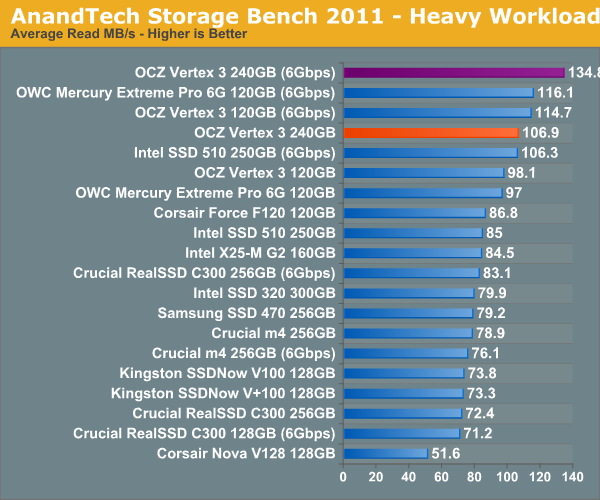
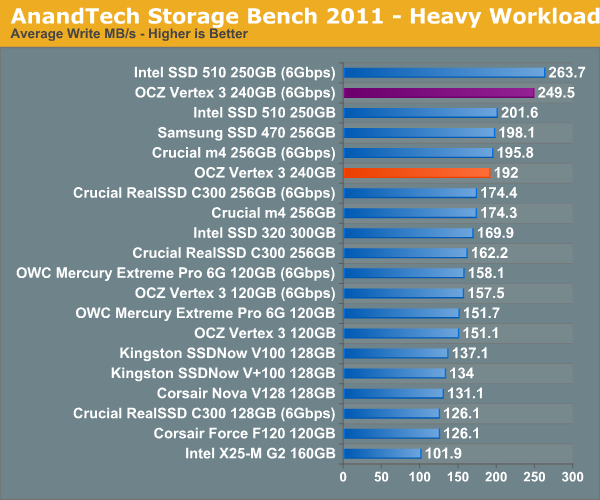
The next three charts just represent the same data, but in a different manner. Instead of looking at average data rate, we're looking at how long the disk was busy for during this entire test. Note that disk busy time excludes any and all idles, this is just how long the SSD was busy doing something:
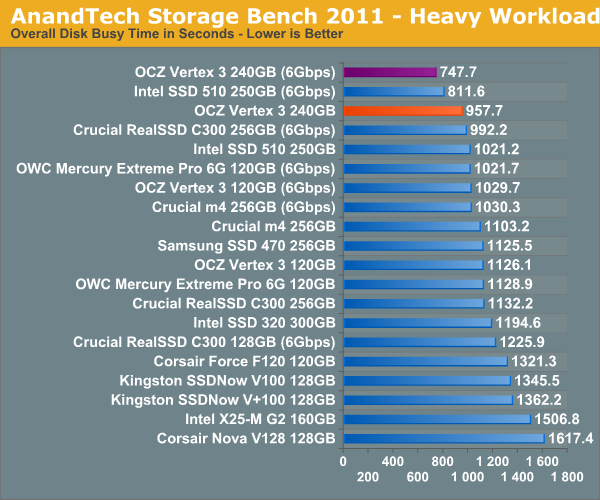
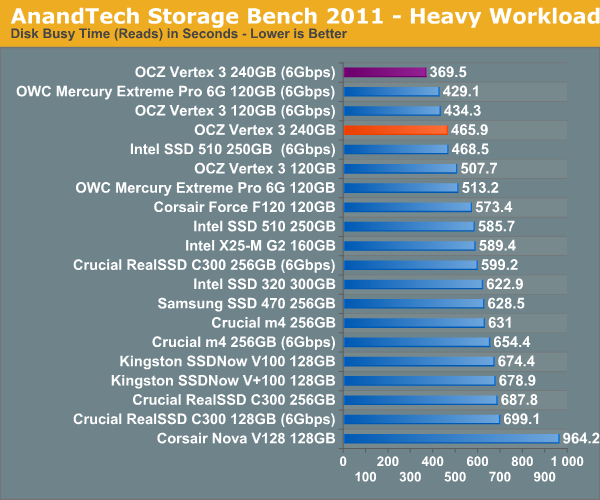
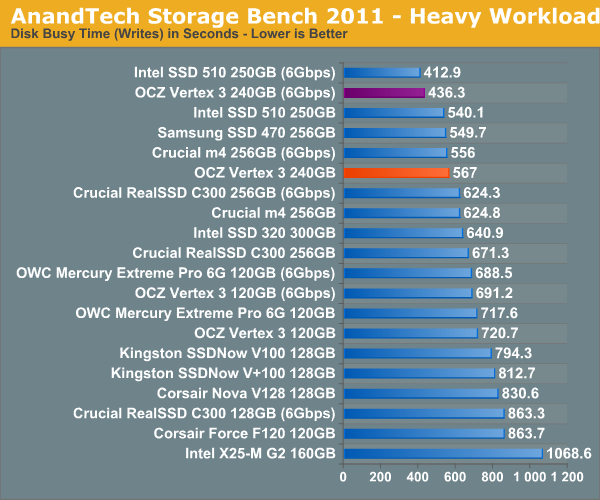










90 Comments
View All Comments
explorer007 - Monday, May 23, 2011 - link
I got exacltly same problem even after firmware 2.06! Anyone better luck?beelzebub253 - Saturday, May 28, 2011 - link
For those of you using Vertex 3 in AHCI mode with the Intel RST drivers, have you tried the LPM Disable fix discussed below?http://forums.crucial.com/t5/Solid-State-Drives-SS...
Check the Event Viewer (System Logs) for an error about iaStor: "did not respond within the timeout period". The entries will be at the exact time of your freeze-ups. Mine had the same problem until I applied the reg fix.
sequoia464 - Wednesday, May 11, 2011 - link
I wonder how this matches up against the Samsung 470.I guess we will never know as it appears that the Samsung 470 has still not been reviewed here at AnandTech.
Hint.
tannebil - Thursday, May 12, 2011 - link
I just installed a 120GB IOPS and I'm seeing ~240MB/s in AS SSD for sequential write. That's 50% higher than you got in your test last month of the regular 120GB model. My understanding is that the sequential performance should be quite similar between the IOPS and regular model so there's something odd going on. My sequential read results match yours.If you look across all the different tests, the AS SSD write results seem to be an outlier since the drive is a great performer in all the rest of the benchmarks. The OWC driver had the same odd results so maybe it's something specific to the SF 2200 controller and your test platform.
My system is a Biostar TH67+ H67 motherboard with a i5-2400 processor with the SSD is connected to an SATAIII port as the boot drive (Windows 7 HP).
johnnydolk - Monday, May 16, 2011 - link
Here in Denmark the Vertex 3 retails slightly cheaper than the Intel 510, but at 25% more than the Crucial M4, which brings the latter on par with the older Vertex 2. This is for the 240/250/256GB versions.I guess the M4 is the one to get if value for money matters?
werewolf2000 - Friday, May 27, 2011 - link
Hi, I'm a bit disappointed. Read all the reviews and was excited about Vertex 3.Got it recently ... but, I'm sorry to say it, it is not good. It maybe fast, but it is freezing. For a little while just sometimes, but it is. It has some consequences, for example when you play mp3, you hear some annoying sounds every 1 - 2 minutes. Seems I'm not the only one having these issues, the tricks from here http://geekmontage.com/texts/ocz-vertex-3-freezes-... help partially, but not fully.
I had Intel G1 some time ago, it behaved similarly after several months of usage, Intel G2 didn't have such issues at all. Now the "best" Vertex 3 has these problems from the beginning (I had two of them, one failed immediately, the second one still lives but freezes).
Maybe, Anand, you could test things like that? Speed is not all, freezing is VERY annoying.
zilab - Saturday, June 4, 2011 - link
Hi Anand,
Great article, just a question:
WIll having a pair of 120GB in RAID 0, make this a non-issue? in terms of speed and resiliency ?
Mohri - Tuesday, August 23, 2011 - link
Thanks Anand for nice reviews,i got macbook pro 2011- Intel i7 2.2 - 8gb ram - 1gb ddr5 video
and i want to install a ssd for it, now i wanted to ask you to recommend me which brand is better for me?
Thank you very much
samehvirus - Saturday, August 27, 2011 - link
To make it short for you all .... OCZ rushed the drive to the market, they want you to BETA Test it, you are stuck with them the moment you buy it, they will keep you in their "RMA or wait for firmware Loop" this SSD is a big "AVOID IT" for main drive (OS+Programs/etc) it will annoy you to no end and a solution atm as of may 26 does not exist neither OCZ admit it yet even when plenty of people are reporting the same issue, they will always try to blame your other hardware or software for the BSOD and never about their own SSDIf you want to be a beta tester go ahead and buy it, OCZ got no solution to offer atm, they are basically selling a product that works 90% of the time so some users wont notice it (those who use their computer 1-2hours a day) if you leave your computer +5hours a day or on all the time prepare to a daily BSOD, Until OCZ offer a solution .
paul-p - Saturday, October 22, 2011 - link
After 6 months of waiting for OCZ and Sandforce to fix their firmware from freezes and BSOD's, I can finally say it is fixed. No more freezes, no more BSOD's, performance is what is expected. And just to make sure all of the other suggestions were 100% a waste of time, I updated the firmware and DID NOT DO anything else except reboot my machine and magically everything became stable. So, after all these months of OCZ and Sandforce blaming everything under the sun including:The CMOS battery, OROM's, Intel Drivers, Intel Chipsets, Windows, LPM, Hotswap, and god knows what else, it turns out that none of those issues had anything to do with the real problem, which was the firmware.
While I'm happy that this bug is finally fixed, Sandforce and OCZ have irrepairably damaged their reputation for a lot of users on this forum.
Here is a list of terrible business practices that OCZ and Sandforce have done over the last year...
OCZ did not stand behind their product when it was clearly malfunctioning is horrible.
OCZ did not allow refunds KNOWING that the product is defective is ridiculous.
OCZ nor Sandforce even acknowledged that this was a problem and steadfastly maintained it only affected less than 1% of users.
The fact that OCZ claims this bug affected 1% of users is ridiculous. We now know it affected 100% of the drives out there. Most users just aren't aware enough to know why their computer froze or blue screened.
OCZ made their users beta test the firmwares to save money on their own testing
OCZ did not have a solution but expected users to wipe drives, restore from backups, secure erase, and do a million other things in order to "tire out" the user into giving up.
OCZ deletes and moves threads in order to do "damage control and pr spin".
But the worst sin of all is the fact that it took almost a year to fix such a MAJOR bug.
I really hope that OCZ learns from this experience, because I'm certain that users will be wary of Sandforce and OCZ for some time. It's a shame, because now that the drive works, I actually like it.